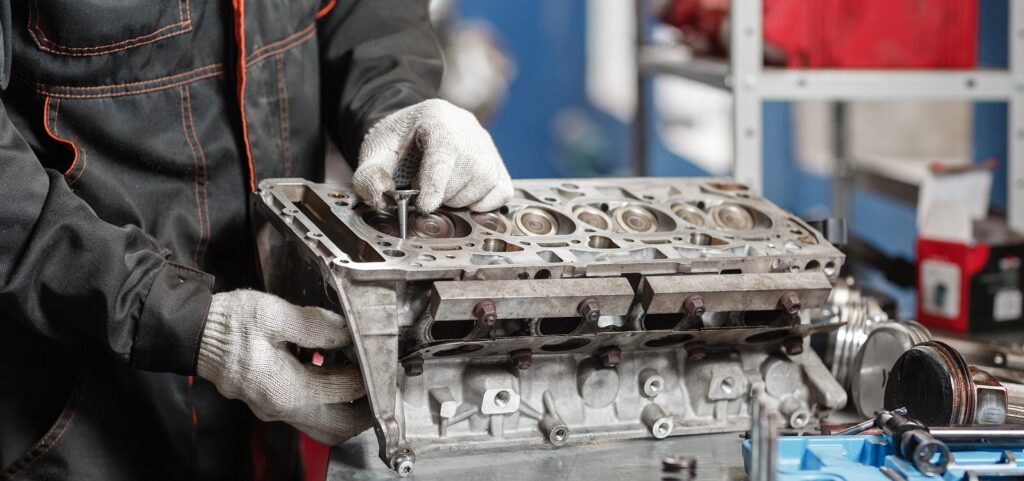What Is a Flywheel
What does a car flywheel look like? When we open engine hood, the first thing that catches our eye is a large thick iron plate that looks like a gear. This is auto flywheel.
The flywheel in vehicle is a disc-shaped part with a large moment of inertia, which acts as an energy storage machine. Its weight is concentrated at the rim of the wheel. And that is to ensure a large moment of inertia with a small self-weight.
Why Is It Called Flywheel
The word flywheel is taken apart as fly and wheel, which means a wheel that turns fast.
People often say flywheel effect, also related to the principle of the flywheel. Flywheel effect means that a stationary flywheel needs a lot of kinetic energy to rotate. But when the flywheel runs at a high speed, it will rotate spontaneously without any effort and maintain the original motion.
Types of Flywheel
- Solid disc flywheel. This is a round solid disc typically used in cast iron single flywheel thresher systems.
- Rimmed flywheel. A rimmed flywheel has a rim, a hub, and spokes.It will detonate at a much lower rotary speed than a solid disc wheel of the same weight and diameter.
- High-velocity flywheel. It has a velocity between 30K rpm to 80K rpm. Besides, This type of wheel has magnetic levitation bearing and require little maintenance.
- Low-velocity flywheel. It has a velocity of 10000 rpm. This kind of wheel is heavier than the high-velocity Flywheel. It requires periodic maintenance and does not use magnetic levitation bearings.
Working of Flywheel
- Store energy and ensure steady rotational speed. This is a common function of flywheel. When the engine speed increases, the kinetic energy increases and saves the energy. On the contrary, when the engine speed decreases, the kinetic energy decreases and the energy is released. This role enable the vehicles maintain a stable speed and drive more smooth.
- Transfer force to the driving wheels. The flywheel is the driving part of the friction clutch. Through the combination and separation of the clutch, the engine rotation force is transferred to the driving wheel by the gearbox.
- Make the engine start better. There is a gear ring on the outer ring of the flywheel, which meshes with the drive gear of the starter. Therefore it will drive the rotation of the crankshaft to start the engine.
- Adjust the valve. The flywheel is engraved with pointer marks, which are used to correct the timing of the ignition part or the fuel pump, and to adjust the valve.
Position of Flywheel Installation
The car flywheel and crankshaft are assembled together and mounted on the end of the crankshaft. It’s a steel disc that combines to the clutch.
Symptoms of Bad Flywheel
- The engine makes an abnormal noise when it is working, accompanied by obvious shaking.
- The transmission is unbalanced.
- The flywheel makes abnormal noise.
- The gear end of the flywheel has serious loss or broken teeth.
- The surface of the flywheel appears severe burning, bump marks, scratches.
- The wear depth of the flywheel groove is greater than 0.5mm.
People Also Ask
Most cars use 4-stroke engines. But in the whole working cycle, only the power stroke produces power. The other intake, compression, and exhaust strokes consume power. The flywheel adds a moment of inertia to the crankshaft, converting a part of the output work of the power stroke into the kinetic energy of the flywheel and storing it for overcoming the resistance of the other three strokes. Therefore, the fluctuation of the engine speed will not be too large, and the output torque will be more stable.
Even if the multi-cylinder engine does work at intervals, the operation of the crankshaft will be extremely uneven, and the speed will fluctuate up and down. And the engine will stall if there is a little resistance, and it is difficult to continue to run.
Both gasoline and diesel engines have flywheels, but the diesel engine flywheel is bigger and heavier.
In addition, a single-cylinder machine has a large and heavy flywheel. Because only one of the four strokes does work, and a heavy flywheel must be used to ensure the stability of the speed. Oppositely the flywheel of the multi-cylinder engine is very small.
When storing energy, the electric energy drives the motor to run, then the motor drives the flywheel to accelerate the rotation. So the flywheel stores the energy in the form of kinetic energy, which completes the process of converting electric energy into mechanical energy. After that, the motor maintains a constant speed until it receives signal to release this energy.
When releasing energy, the flywheel drives the motor to generate electricity and outputs current and voltage Therefore it completes the process of converting mechanical energy to electrical energy.
Read More
- Cylinder Head- This Article Lets You Know All
- An Overview of Flywheel Definition Function and Position
- About Kowze!



